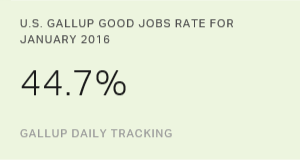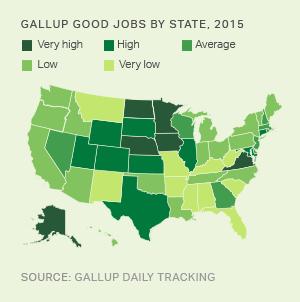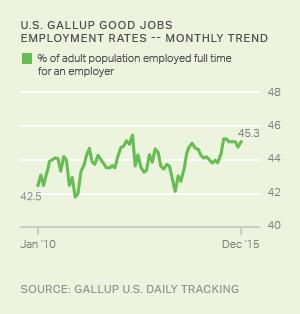Story Highlights
- January 2016 Gallup Good Jobs half a point higher year on year
- Unemployment drops to new low of 5.5% in Gallup's trend
- Underemployment steady at 14.0%
WASHINGTON, D.C. -- The Gallup Good Jobs (GGJ) rate in the U.S. was 44.7% in January. This is down from the rate measured in December (45.3%) but higher than in any January since Gallup began measuring it in 2010. The current rate is 0.6 percentage points higher than in January 2015. This suggests an underlying increase in full-time work beyond seasonal changes in employment.
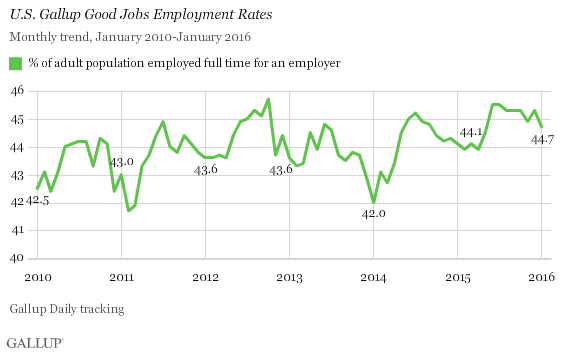
The GGJ metric tracks the percentage of U.S. adults, aged 18 and older, who work for an employer full time -- at least 30 hours per week. Gallup does not count adults who are self-employed, work fewer than 30 hours per week, are unemployed or are out of the workforce as payroll-employed in the GGJ metric.
The latest results are based on Gallup Daily tracking interviews with 30,389 U.S. adults, conducted Jan. 2-31 by landline telephone and cellphone. GGJ is not seasonally adjusted.
Workforce Participation at 66.8% in January
The percentage of U.S. adults in January who participated in the workforce -- by working full time, working part time or actively seeking and being available to work -- was 66.8%. This is down slightly from the rate in December (67.3%), and is the third month in a row that workforce participation has declined.
It is also the first time since Gallup began tracking workforce participation in January 2010 that participation has declined from December to January. Gallup's workforce participation measure averaged 67.7% between January 2010 and June 2013, but since then has averaged about one percentage point lower, at 66.9%.
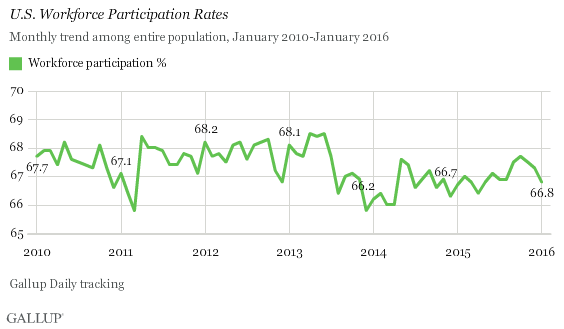
Unemployment at 5.5%
Gallup's unadjusted U.S. unemployment rate was 5.5% in January, statistically even with December's 5.6% and the lowest in any month since Gallup began tracking the measure in 2010. The unemployment rate in January 2015 was 7.1%. Gallup's U.S. unemployment rate represents the percentage of adults in the workforce who did not have any paid work in the past seven days, either for an employer or themselves, and who were actively looking for and available to work.

Unlike Gallup's GGJ rate, which is a percentage of the total population, the unemployment rates that Gallup and the U.S. Bureau of Labor Statistics report are percentages of the labor force. While both Gallup and BLS data are based on surveys with large sample sizes, the two have important methodological differences -- outlined at the end of this article. Additionally, the most discussed unemployment rate released by the BLS each month is seasonally adjusted, while Gallup reports unadjusted numbers. Although Gallup's unemployment numbers strongly correlate with BLS rates, the BLS and Gallup estimates of unemployment do not always track precisely on a monthly basis.
Underemployment Steady at 14.0%
Gallup's measure of underemployment in January was 14.0%, steady with December and in line with the rates since July 2015. Gallup's U.S. underemployment rate combines the percentage of adults in the workforce who are unemployed (5.5%) with those who are working part time but desire full-time work (8.4%); these two figures add to 14.0% after rounding.

Bottom Line
GGJ typically falls in January, and this past month was no exception. However, GGJ has been the same or higher year on year each month since May 2014, indicating an overall strengthening of full-time labor market conditions. It remains to be seen whether this trend will continue in the face of weakened economic confidence and high but plateauing job creation in recent months.
The data in this article are available in Gallup Analytics.
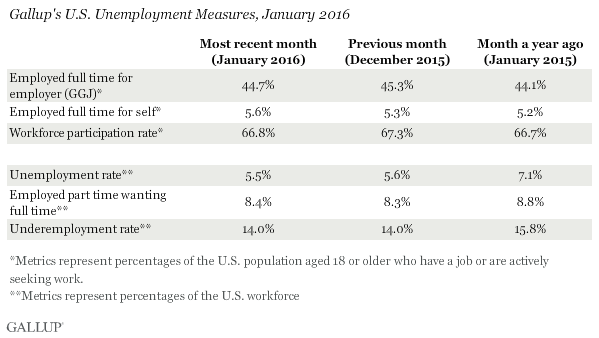
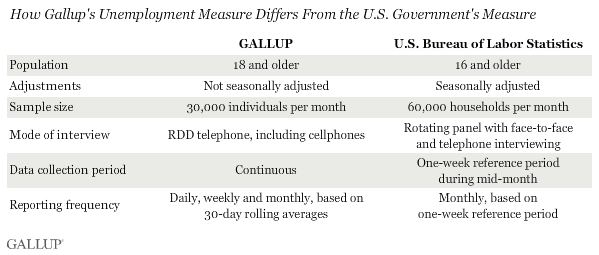
Gallup.com reports results from these indexes in daily, weekly and monthly averages and in Gallup.com stories. Complete trend data are always available to view in the following charts:
Daily: Employment, Economic Confidence and Job Creation, Consumer Spending
Weekly: Employment, Economic Confidence, Job Creation, Consumer Spending
Read more about Gallup's economic measures.
View our economic release schedule.
Survey Methods
Results for this Gallup poll are based on telephone interviews conducted Jan. 2-31, 2016, on the Gallup U.S. Daily survey, with a random sample of 30,389 adults, aged 18 and older, living in all 50 U.S. states and the District of Columbia. For results based on the total sample of national adults, the margin of sampling error is ±1 percentage point at the 95% confidence level. All reported margins of sampling error include computed design effects for weighting.
Each sample of national adults includes a minimum quota of 60% cellphone respondents and 40% landline respondents, with additional minimum quotas by time zone within region. Landline and cellular telephone numbers are selected using random-digit-dial methods.
Learn more about how the Gallup U.S. Daily works.
